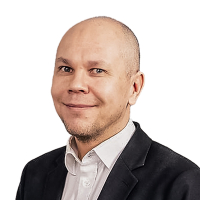Clarity is key to successful grant applications

The Instrumentarium Science Foundation receives hundreds of grant applications every year. They are reviewed and ranked by top Finnish experts. Clarity and project impact are important for the success of applications.
What does clarity actually mean in a grant application? According to Mika Rämet, Professor of Paediatrics and Medical Director of Finnish Vaccine Research (FVR), clarity means succinctly and concisely explaining why the study presented in this particular application is worthy of funding. Rämet, who reviews grant applications for the Instrumentarium Science Foundation, also advises applicants to be realistic in their applications and research plans.
‘A good application is written in clear language and the research plan outlines what the funding will help achieve during the research period. Research funders are understandably very interested in how big an impact the money they award can have. If the research topic is in a highly competitive field, he recommends highlighting the competitive advantage of the study presented in the application in comparison to other studies. This kind of international rivalry exists in almost all medical research today,’ Rämet explains.
As with all papers and reports, Rämet claims that a good grant application should always have a convincing title and summary. The research methodology also interests the reviewers and should be carefully explained in the application.
Ask outsiders for comments
A good grant application doesn't just happen. Competition is fierce and the quality of applications is constantly improving. Rämet, who has been reviewing applications for the Instrumentarium Science Foundation for five years, wants to remind applicants of the importance of good preparation and planning.
‘It’s always a good idea to ask as many colleagues in your field and members of your research team as possible to read through the application before you submit it. If you can, it is also worth asking for comments from people from outside your field. They may see areas for improvement in the application that insiders in the same field don’t necessarily notice. Comments from external sources may make the application clearer and therefore better,’ says Rämet.
Peer review is effective
Reviewing applications is solitary work, and for some, perhaps a little lonely. The Foundation's grant reviewers rarely meet each other, at least not for review purposes.
Rämet reviews several applications on the same topic at the same time. This ensures that the applications are on equal footing and are processed in the fairest possible way. He carefully goes through the applications and gives them a school grade of between 4 and 10. At the same time, he ranks all the applications he receives in order of merit. The results of the review are reported to the Foundation via an electronic system, which Rämet praises for its functionality and usability.
‘I see reviewing as an essential part of a professor's academic work. I’m a strong believer in peer review and its effectiveness. In a way, reviewing also provides a vantage point from which to follow the latest research trends. It's time-consuming work, but also interesting and straightforward. Foundations are very important funders of medical research. For them, reviewing is crucial, because they have to rank the applications according to how good they are. Unfortunately, there’s not enough money for even all good projects,’ says Rämet.
Feedback can lead to better applications
A key part of the review is the feedback that researchers receive on their application. If they are not awarded a grant in that particular round, it’s worth reading the feedback carefully and remembering it. By following the advice they receive, they may be more successful in the next round.
‘Each application is a separate entity. However, the review is ultimately conducted on a case-by-case basis. Funding must not be a reward for previous good work. The more significant the amount of research funding, the more expertise is required of the applicant, and the greater the potential impact of the project,’ Rämet points out.
Text: Kai Tarkka
Image: FVR
